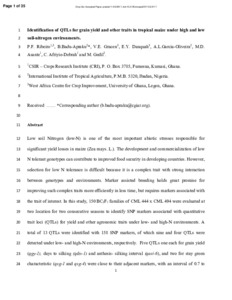| dc.contributor.author | Ribeiro, P.F. |
| dc.contributor.author | Badu-Apraku, B. |
| dc.contributor.author | Gracen, V.E. |
| dc.contributor.author | Danquah, E.Y. |
| dc.contributor.author | García Oliveira, A.L. |
| dc.contributor.author | Asante, M.D. |
| dc.contributor.author | Afriyie-Debrah, Charles |
| dc.contributor.author | Gedil, M. |
| dc.date.accessioned | 2019-12-04T11:11:04Z |
| dc.date.available | 2019-12-04T11:11:04Z |
| dc.date.issued | 2017 |
| dc.identifier.citation | Ribeiro, P.F., Badu-Apraku, B., Gracen, V.E., Danquah, E.Y., Garcia-Oliveira, A.L., Asante, M.D., ...& Gedil, M. (2017). Identification of QTLs for grain yield and other traits in tropical maize under high and low soil-nitrogen environments. Crop Science, 1-35. |
| dc.identifier.issn | 0011-183X |
| dc.identifier.uri | https://hdl.handle.net/20.500.12478/2340 |
| dc.description | Article purchased; Published online: 03 Nov 2017 |
| dc.description.abstract | Low soil Nitrogen (low-N) is one of the most important abiotic stresses responsible for significant yield losses in maize (Zea mays. L.). The development and commercialization of low N tolerant genotypes can contribute to improved food security in developing countries. However, selection for low N tolerance is difficult because it is a complex trait with strong interaction between genotypes and environments. Marker assisted breeding holds great promise for improving such complex traits more efficiently in less time, but requires markers associated with the trait of interest. In this study, 150 BC2F1 families of CML 444 x CML 494 were evaluated at two location for two consecutive seasons to identify SNP markers associated with quantitative trait loci (QTLs) for yield and other agronomic traits under low- and high-N environments. A total of 13 QTLs were identified with 158 SNP markers, of which nine and four QTLs were detected under low- and high-N environments, respectively. Five QTLs one each for grain yield (qgy-1), days to silking (qdts-1) and anthesis- silking interval (qasi-6), and two for stay green characteristic (qsg-1 and qsg-4) were close to their adjacent markers, with an interval of 0.7 to 5.2 cM between them and explained phenotypic variance of 9 to 21%. These QTLs would be invaluable for rapid introgression of genomic regions into maize populations using marker assisted selection (MAS) approaches. However, further validation of these QTLs is needed before use in MAS. |
| dc.description.sponsorship | Alliance for a Green Revolution in Africa |
| dc.description.sponsorship | Bill & Melinda Gates Foundation |
| dc.format.extent | 1-35 |
| dc.language.iso | en |
| dc.subject | Maize |
| dc.subject | Food Security |
| dc.subject | Abiotic Stress |
| dc.subject | Soil Nitrogen |
| dc.subject | Yield |
| dc.subject | Quantitative Trait Locus |
| dc.subject | Marker Assisted Selection |
| dc.title | Identification of QTLs for grain yield and other traits in tropical maize under high and low soil-nitrogen environments. |
| dc.type | Journal Article |
| dc.description.version | Peer Review |
| cg.contributor.crp | Grain Legumes |
| cg.contributor.crp | Maize |
| cg.contributor.crp | Roots, Tubers and Bananas |
| cg.contributor.affiliation | Council for Scientific and Industrial Research, Ghana |
| cg.contributor.affiliation | International Institute of Tropical Agriculture |
| cg.contributor.affiliation | University of Ghana |
| cg.coverage.region | Africa |
| cg.coverage.region | West Africa |
| cg.coverage.country | Ghana |
| cg.isijournal | ISI Journal |
| cg.authorship.types | CGIAR and developing country institute |
| cg.iitasubject | Genetic Improvement |
| cg.iitasubject | Integrated Soil Fertility Management |
| cg.iitasubject | Maize |
| cg.iitasubject | Plant Genetic Resources |
| cg.iitasubject | Soil Fertility |
| cg.iitasubject | Soil Health |
| cg.journal | Crop Science |
| cg.howpublished | Formally Published |
| cg.accessibilitystatus | Open Access |
| local.dspaceid | 92193 |
| cg.targetaudience | Scientists |
| cg.identifier.doi | http://dx.doi.org/10.2135/cropsci2017.02.0117 |

